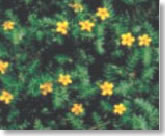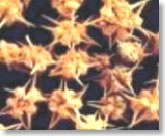
GOKSHURA
Botanical Name: Tribulus terrestris (ZYGOPHYLLACEAE)
English Name: Calthrops
Hindi Name: Gokhru, Bhakra Chota gokhru

Introduction: The usage of Gokshura dates back to Vedic period. Sanskrit grammarian Panini quoted this herb in his work ( Panini Ghana Patha, 4/3//154). Charaka described it as Mutra virecaniya (diuretic), Sotha hara (anti-inflammatory) and krimighna ( anti-microbial). This herb is known for its effect on filtration defects of renal system and urinary tract infections Prameha (diabetes) in Indian medicine.
Distribution: This procumbent herb is found throughout India as a common weed in dry, waste lands during rainy season, particulary in sandy soils of Punjab, Haryana, Rajasthan, UP, MP etc.
Parts Used: Root, Fruit & Whole Plant
Properties: Sweet & Astringent, subsides vata & Kapha, tonic, aphrodisiac etc.
Dose: decoction 50-100 ml/day, fruit powder-3 to 6g
Therapeutic Uses:
- Joint pains: decoction of dry ginger+gokhru( equal parts) at a dose of 50-100ml/day.
- Hair growth: paste of gokhru & flowers of sesamum mixed with honey for external use.
Scientific Studies:
Nephtoprotection: At a dose of 200 mg/kg/day p.o it proctected rats against gentamycin-induced renal damage in both structural and functional terms ( Nagarkatti et al., 1994).
Lithotriptic activity: AE at a dose of 5 g/kg/ b.w. administered to sodium glycolate fed rats produced a significant reduction in urinary oxalate excretion, and a significant increase in urinary glyoxylate excretion as compared to in sodium glycolate fed animals (Sangeeta et al., 1994).
Urinary tract infections: Useful in UTIs as reported by Adhav (1985), Polly (1987), Khosale(1991) etc.
Diuretic activity: Decoction of fruit in rats ( Gujral et al., 1955) and Ae in rats and dogs exhibited diuretic effect ( Karandikar et al., 1960).
Other uses include infertility, hypertension, liver disorders, infections, cancer etc.
Cultivation Technology: The plant grows well in sandy soil where there is a good drainage. The land is ploughed well and seeds are sown in nursery in the month of June-July. 10-15 cm long seedlings are transplanted to the main plots at the distance of 15x15cm. Irrigate the field immediately after transplanting and in late stages, it does not require much water.
Harvesting: Fruits can be collected during September-November. Dig-out the roots, clean and dry before sale. Now a days, whole plant is also sold in the trade.







